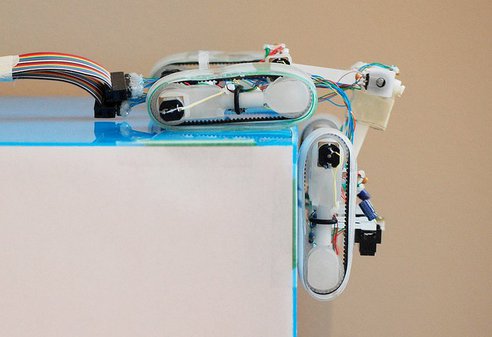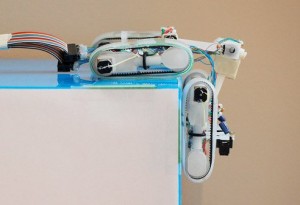
Simon Fraiser University researchers have taken a page from the gecko “walk on any surface” handbook and applied it to a robot that looks a bit like a tank.
If you’ve never seen a gecko just hanging out on glass, it’s rather amazing. Not a whole lot of animals the size of a gecko can manage to just stand there on glass like it’s nothing.
Up close, you can see gecko have rather unusual feet that allow such a feat.
And that’s where these robot get their inspiration. Only instead of specially textured feet, the tank-like robot uses a unique dry adhesive.
As Discovery News reports, “For a climbing robot to be practical, it needs to adhere to surfaces without leaving a gooey trail. That’s why scientists are interested in dry adhesive methods, as opposed to wet adhesion, which may leave behind tacky or glue-like substances. The robot also needs to be able to traverse a wide range of surfaces. Some robots use suction, but that requires a lot of power pumping air. Other robots use claws, but those need something to grab onto. Some robots use magnets, but those only work with metal. That’s why the researchers decided to imitate the gecko, which is unique among vertebrates in its ability to scramble up vertical surfaces, no matter what the texture. Unlike animals that use claws to climb (squirrels, for instance), suction (some frogs) or even glue (a slug), a gecko sticks to walls and ceilings using the very force that attracts molecules together, called the Van der Waals force.”
The “Tailless Timing Belt Climbing Platform (TBCP-11)” can move from flat surfaces to vertical walls at speeds of up to 3.4 cm per second.
SFU reports, “The research…provides an alternative to using magnets, suction cups or claws which typically fail at climbing smooth surfaces like glass or plastic. It also paves the way for a range of applications, from inspecting pipes, buildings, airplanes and even nuclear power plants to employment in search and rescue operations… Researchers mimicked the “dry, sticky toe pads” of the gecko by creating an adhesive using a material called polydimethylsiloxane (PDMS), manufactured as tiny mushroom cap-like shapes that are 17 micrometres wide by 10 micrometres high.”
We recently saw another robot that uses the gecko as inspiration to figure out how to climb glass surfaces. However, that one uses more of a shimmying movement and requires water to keep it suctioned to the glass. This new tank with mushroom cap-shaped artificial setae (the hairlike growths on gecko feet that help them cling to surfaces) seems much more effective.
The mushroom cap shape allows the setae on the treads to release at an angle, so no extra force is require to unstick them from a surface. That’s what allows the tank to roll forward with ease, without dropping off the surface.
The new prototype bot will eventually be made to be fully autonomous, detecting its surroundings and navigating accordingly. It’s rather astonishing to watch in action:
Source: treehugger

 Follow
Follow

